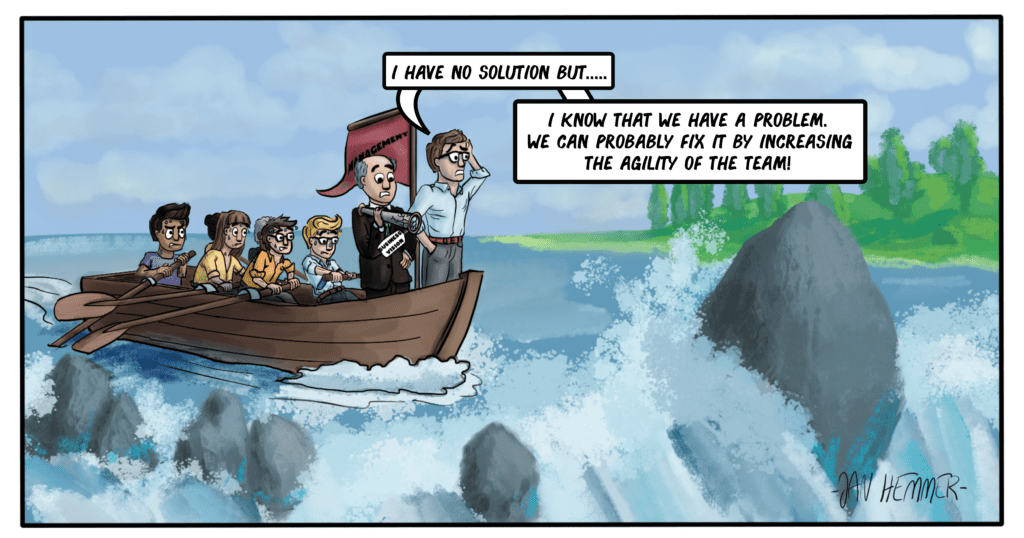Nowadays, quickly changing markets are the norm for most industries. As a consequence, products, sales channels, brand image, and business models of any enterprise require ongoing attention. From time to time, tough decisions are needed, which change the direction of the business – for example, if companies abandon outdated product lines or enter new business areas with all their risks and uncertainties. These decisions typically have to be made by the top management. For the managers concerned, these decisions mean a lot of personal trouble and risk. In times of “agility” we increasingly often see that inconvenient and risky decisions are delegated to the “teams” or postponed after agile reorganizations.
So, let’s have a closer look. Shall we?
The title of a blog published a couple of years ago essentially stated that ‘business strategy does not matter if you are not agile’. Such a publication is not unique. Over the last two decades, “agile” has penetrated practically every facet of business activity fueled by many writings, discussions, and occasional success stories from a range of professionals, from highly reputed management consulting firms to enthusiastic blog writers. These publications are often quick to position agile as ‘the secret’ behind stellar business excellence. Are indeed agile practices the panacea for all major business issues, the ‘penicillin’ for all critical business ailments?
How about considering another statement: “agile does not matter if you do not have (the right) business vision and strategy”? Amongst other things, agile approaches provide a higher level of freedom of decision making and individual actions, and usually help speed up execution of required activities to reach a certain goal. But what if ‘the goal’ is not well-defined or even worse not a purposeful one. Would it not be like hurrying up the achievement of a wrong result with agile practices (and then, possibly, blaming agile as the main reason for the ultimate failure)?
A healthy business must have a certain level of internal operational efficiency and external market competitiveness. This requirement is even more critical for businesses that are impacted by present-day digital technologies.
Many businesses fail to produce growth or profit due to inefficient internal processes. Likewise, many well-known brands that were once industry stalwarts have succumbed to obscurity or extinction due to misalignment with prevalent and emerging market trends – examples like Nokia, Xerox, Sears (an iconic American home appliance store chain), Borders (an upscale bookstore chain) and Blockbuster (the leading in-store movie rental chain in the US) are not hard to find. If a business has the right vision and fitting goals and strategies to improve its condition, whether from throws of closure to survival or from healthy survival to sky-rocketing market leadership then by all means (agile approaches included) the required actions should be sped up.
Imagine a situation where a high-end household appliances manufacturer is struggling to gain adequate market share. The manufacturer’s products have nice styling and colours. The manufacturer is continuously pushing, using agile approaches, new hardware and software features into their refrigerators, kitchen ovens, and washing machines so new versions of the products are appearing in the market rapidly. Let’s also assume that these appliances also have to market competitive pricing. Yet, consumer uptake is slow. What can be the problem?
The appliance manufacturer in our example investigates the cause of the failure to attract the right volume of customers. As a result, it realizes that in spite of all the advanced features, many choices of models and good prices, the overall reliability of the products has been quite low – frequent failure of hardware components, buggy software controls, and so on. At this point, the manufacturer can either prioritize improving the reliability of its products and changing the market perception or continue with or even speed-up delivery of new versions of its products hoping that the customer will forget the bad experiences with older versions and try the new ones. Even commonsensical, the first option has a good chance to save the business and the second will most likely drive it to the ground, no matter how good the manufacturer is with its adoption of agile; it will be the business vision of the manufacturer that will help the manufacturer take the right decision.
Agility can not replace a business strategy
There is no merit to adopting agile in a dying business unless there is a resolve to alter the course of business evolution to a better future and to have the corresponding goals, strategies, and tactics to steer the business through that new or modified path.
This requires leadership and innovative ideas to trigger and sustain the necessary changes in organizational behaviour, processes, technologies, ambitions for products and services. Before digging deeper into the connection between business vision and agile, let us quickly refresh ourselves with the definitions of a few relevant concepts:
Business Vision and Mission – “Vision” defines the aspiration of a business, what it wants to become or be recognized as, while “Mission” captures its primary objectives and approaches to business operation. Together, business vision and mission also provide a foundation for the key “Values” of the business.
Business Goals and Strategies – “Goals” are clearly defined targets that a business sets out to achieve over a certain period of time while “Strategies” define how the business needs to act in order to achieve those goals. Goals and corresponding strategies formulated at different levels and granularities within a business fulfil the mission and vision of the business.
Business Innovation – “Innovation” is a combination of ideas and ways a business creates new or modifies existing operational processes, methodologies, products, services, and even the business model in order to achieve positive change, creating new value, and market competitiveness.
Business Agility and Agile – “Agility” is the ability of a business to change rapidly its goals, strategies, structure, processes, technology, and behaviour to either protect itself against a business threat or to grab a business opportunity. “Agile”, on the other hand, is an approach for conducting the required activities fast and often with higher efficiency. Agile approaches, when appropriate, can be used in practically all facets of business activities including development of technologies, products, and services. As such agile approaches can support the bigger concept of business agility.
Foster creativity and innovation
An agile business with the right vision and mission, equipped with appropriate goals and strategies, having the innovation capability to solve problems or cash-in on new opportunities, is well prepared to use agile approaches to reach its targets fast. Revisiting the home appliance manufacturer example described earlier, if the business had a vision of being a ‘highly dependable’ brand then in the face of market penetration difficulties it would easily take the decision to first fix the equipment reliability problem before pushing more products and features.
It is easy to find plenty of evidence that agile businesses with the capability to innovate outperform those that lack business agility. For example, a survey reported in a recent McKinsey article titled “Enterprise Agility: Buzz or Business Impact” indicates significant business performance improvements due to business agility along four key dimensions:
- Customer satisfaction: 10-30%
- Employee engagement: 20-30%
- Operational performance: 30-50%
- Financial performance: 20-30%
Current COVID pandemic has also demonstrated strong merits of the combination of business innovation and agility. Businesses that are surviving well through difficult time have quickly come up with creative ideas to serve their customers and engage their employees within the constraints of the pandemic, and have taken these actions fast.
The important thing to note here is that it is the overall business agility along with innovation and not just the use of agile methods in certain activities that provide the performance excellence of the business.
Recommendations
A 2017 McKinsey article titled “How to Create an Agile Organization” lists eighteen key characteristics (labelled as “practices” in the article) of an agile organization. One can observe that these characteristics have the foundation consisting of:
- Clear vision and mission that are shared, understood and internalised by all concerned
- Ability to sense problems and opportunities, and react fast
- Ability to identify the right goals and strategies before jumping into action
- Actionable decision making and lean (yet adequate) governance
- A performance-oriented organizational culture that embraces change
- A balanced strategy of ‘stable’ and ‘agile’ actions
Summary
Thus, businesses that want to derive substantial benefits from adopting agile practices need additional capabilities beyond practising “scrum”. An expert blog titled “Your path to Agile at Scale” published in August 2020 by Capgemini, a global system integrator, advises enterprises to conduct a serious introspection by asking the right questions about the organizational intent (business vision) and preparedness (strategy) for the adoption of agile approaches before embarking on spreading agile through the organization – this type of exercise is critical for the realization of ‘agile success’ and will protect the business from possible ‘death-by-agile’.

